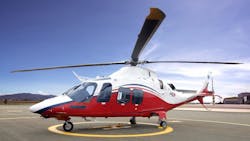Aero Asset Reports Fourth Quarter Preowned Twin-Engine Helicopter Market Improves
Aero Asset reports that while the preowned twin engine helicopter market continued to recover in the fourth quarter of 2020, retail sales volume remained below 2019 levels, impacted largely by the COVID-19-induced economic downturn. The Canadian-based helicopter trading firm just released its fourth quarter 2020 Heli Market Trends report and plans to release a 2020 annual market report before the end of the first quarter 2021.
“Fourth quarter 2020 retail sales volume rose 22 percent compared to third quarter, but remained 25 percent below fourth quarter 2019,” said Aero Asset Sales Director Emmanuel Dupuy. “Twin preowned supply for sale remained stable in the fourth quarter, but still 10 percent higher year over year.”
Absorption rate continued to improve in the fourth quarter but remained 50 percent higher year over year. The deal pipeline bounced back last quarter, surpassing 2019 fourth quarter level.
Weight Class Discord
The light twin engine market was stable in the fourth quarter after a strong rebound the previous quarter. Deterioration ended in the medium asset class market with an uptick in sales volume and a stable level of supply while the heavy market stood at a standstill in the fourth quarter, after a decent third quarter 2020.
VIP Dominates Configuration Activity
The VIP market segment was stable in the fourth quarter, compared to the third, but sales volume remained 15 percent below the 2019 fourth quarter. VIP sales represented 64 percent of all trading activity, with Utility and EMS configurations accounting for the rest.
Liquidity Lineup
The most liquid preowned markets in the fourth quarter of 2020 were the Airbus Helicopters H135 and H145, which tied at first place. Two of 12 markets in the lineup saw no trades during the fourth quarter, both in the heavyweight class. The least liquid market with trading activity was the Bell 412EP, which continued to suffer from lack of demand.
Deal Pipeline Bounces Back
After four consecutive quarters of decline in the number of deals pending at various stages of transactions, the deal pipeline grew during the fourth quarter. It bounced back to surpass fourth quarter 2019 level.

